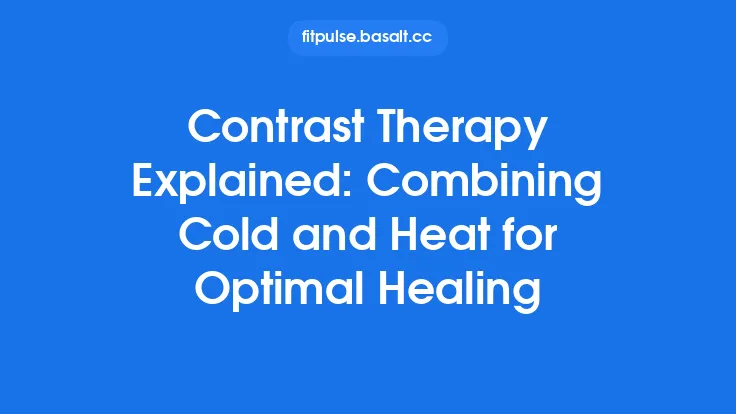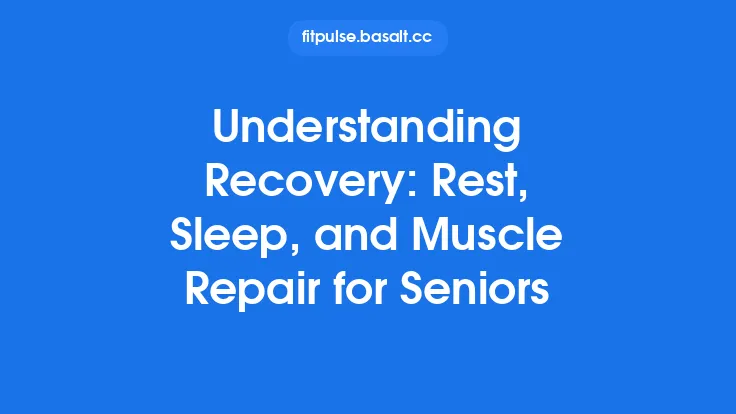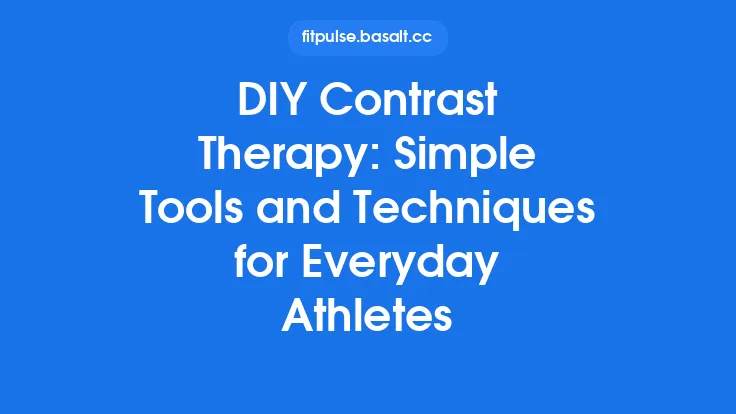Contrast therapy, also known as hot‑cold immersion or alternating temperature therapy, is a recovery modality that leverages the physiological responses triggered by rapid shifts between heat and cold. By cycling the body through vasodilation and vasoconstriction, athletes and fitness enthusiasts can accelerate the removal of metabolic waste, reduce inflammation, and promote tissue repair after strenuous activity. While the practice has roots in ancient traditions—such as Roman baths and Nordic sauna‑cold plunge rituals—modern research has begun to clarify the mechanisms that make contrast exposure an effective tool for muscle recovery, joint health, and overall performance readiness.
The Science Behind Temperature Cycling
Vascular Dynamics
When a muscle group is exposed to heat (typically 38‑40 °C/100‑104 °F), blood vessels dilate, increasing blood flow and delivering oxygen‑rich plasma to the tissues. This vasodilation also raises the temperature of the extracellular matrix, which can improve the elasticity of collagen fibers and reduce joint stiffness.
Conversely, cold exposure (usually 10‑15 °C/50‑59 °F) induces vasoconstriction, narrowing the lumen of blood vessels and temporarily limiting blood flow. The sudden reduction in perfusion helps to limit the extravasation of plasma proteins and inflammatory mediators into the interstitial space, thereby curbing edema.
The alternating sequence creates a “pump” effect: each transition from hot to cold (and vice‑versa) forces blood to move in and out of the affected area, enhancing the clearance of lactate, cytokines, and cellular debris while delivering fresh nutrients and oxygen.
Neuromuscular Effects
Thermal stimuli activate temperature‑sensitive ion channels (TRPV1 for heat, TRPM8 for cold) on sensory neurons. This activation modulates the firing rate of afferent fibers, which can lead to a temporary reduction in pain perception—a phenomenon known as “gate control.” Additionally, the rapid temperature shift can stimulate the release of endogenous opioids and endocannabinoids, further contributing to analgesia.
Cellular Metabolism
Heat exposure raises the metabolic rate of muscle cells, promoting mitochondrial activity and ATP production. Cold exposure, on the other hand, slows metabolic processes, which can protect damaged cells from oxidative stress. The alternation therefore balances the need for metabolic activation (to drive repair) with protective down‑regulation (to limit secondary damage).
Common Protocols and Their Rationale
| Protocol | Hot Phase | Cold Phase | Cycle Count | Total Duration | Typical Use |
|---|---|---|---|---|---|
| Classic Contrast Bath | 3–4 min at 38–40 °C | 1–2 min at 10–15 °C | 3–5 cycles | 15–30 min | Post‑strength training, moderate‑intensity cardio |
| Short‑Interval Contrast | 1 min at 40 °C | 30 s at 12 °C | 6–8 cycles | 10–12 min | High‑intensity interval training (HIIT) recovery |
| Warm‑Up Contrast | 2 min at 38 °C | 30 s at 15 °C | 2 cycles | 5 min | Pre‑competition to increase muscle temperature and reduce stiffness |
| Passive Contrast (Shower) | 2 min hot water | 30 s cold spray | 3–4 cycles | 10–12 min | Home‑based recovery when immersion tubs are unavailable |
Key considerations when selecting a protocol:
- Training Load: Heavier eccentric loads (e.g., heavy squats) often benefit from longer hot phases to promote tissue extensibility, while high‑intensity sprint work may respond better to shorter, more frequent cycles that prioritize rapid edema reduction.
- Time Constraints: Athletes with limited recovery windows can adopt short‑interval protocols that still generate a vascular pump without requiring a full immersion bath.
- Individual Tolerance: Some individuals experience heightened discomfort during cold phases; adjusting temperature gradients or extending the hot phase can improve adherence.
Equipment Options: From Simple to High‑Tech
- Immersion Tubs: Traditional plastic or stainless‑steel tubs filled with water allow precise temperature control. Adding a circulation pump helps maintain uniform temperature throughout the bath.
- Portable Contrast Systems: Compact units combine a heated water reservoir with a chilled compartment, often using a single pump to circulate water between the two chambers. These are popular in sports clinics and elite training facilities.
- Contrast Showers: Dual‑temperature showerheads deliver alternating streams of hot and cold water. While less immersive, they are convenient for athletes who lack access to a tub.
- Thermal Wraps and Pads: Electrically heated wraps paired with gel‑filled cold packs can simulate contrast exposure on specific muscle groups (e.g., quadriceps or calves). These are useful for targeted therapy when full‑body immersion is impractical.
When choosing equipment, prioritize:
- Temperature Accuracy: ±1 °C stability ensures reproducible results.
- Flow Rate Control: Adjustable circulation speeds allow fine‑tuning of the vascular pump effect.
- Safety Features: Automatic shut‑off, anti‑scald valves, and insulated surfaces reduce the risk of burns or hypothermia.
Integrating Contrast Therapy into a Recovery Plan
- Timing Relative to Training:
- Immediate Post‑Exercise (0–30 min): A brief contrast session (10–15 min) can accelerate lactate clearance and reduce perceived soreness.
- Delayed Recovery (2–4 h post‑exercise): Longer protocols (20–30 min) are more effective for structural repair, as they allow the initial inflammatory cascade to settle before applying thermal stress.
- Complementary Modalities:
- Active Recovery: Light aerobic activity (e.g., cycling at <60 % VO₂max) before contrast exposure can enhance circulation, making the subsequent temperature shifts more effective.
- Nutritional Support: Consuming a protein‑rich snack (20–30 g) within 30 min of contrast therapy supports muscle protein synthesis, capitalizing on the increased blood flow to deliver amino acids to repairing fibers.
- Sleep Hygiene: The thermoregulatory effects of contrast therapy can improve sleep onset by promoting a post‑session drop in core temperature, especially when the final phase is cold.
- Periodization:
- Off‑Season: More frequent contrast sessions (3–4 times per week) can be used to maintain joint mobility and reduce chronic stiffness.
- In‑Season: Limit contrast exposure to 1–2 times per week, focusing on high‑intensity competition days to avoid potential interference with training adaptations.
Evidence Base: What Research Tells Us
- Inflammation Markers: Several randomized controlled trials have shown that contrast baths reduce serum creatine kinase (CK) and interleukin‑6 (IL‑6) levels 24 h after eccentric exercise compared with passive rest.
- Performance Metrics: Meta‑analyses indicate modest improvements (≈2–3 %) in subsequent sprint times and jump height when contrast therapy is applied within 30 min post‑exercise, though the effect size diminishes with repeated exposure over weeks.
- Subjective Recovery: Across multiple athlete populations, perceived muscle soreness (DOMS) scores are consistently lower after contrast protocols, with participants reporting faster readiness for the next training session.
- Long‑Term Adaptations: Emerging data suggest that chronic use of contrast therapy does not blunt strength gains, provided the modality is not applied immediately after every training session. Timing and dosage appear critical to preserving the anabolic signaling pathways necessary for hypertrophy.
Safety Guidelines and Contraindications
| Situation | Recommendation |
|---|---|
| Cardiovascular disease (e.g., uncontrolled hypertension, recent myocardial infarction) | Avoid rapid temperature shifts; consult a medical professional before use. |
| Peripheral neuropathy (e.g., diabetic neuropathy) | Use milder temperature gradients; monitor for loss of sensation. |
| Open wounds or skin infections | Do not immerse; risk of bacterial proliferation in warm water. |
| Pregnancy | Limit hot phases to ≤38 °C and keep exposure under 10 min to prevent hyperthermia. |
| Cold intolerance (Raynaud’s phenomenon) | Skip cold phases or replace with milder cool packs (≈20 °C). |
General safety tips:
- Gradual Transition: Begin each session with a 2‑minute acclimation period at a neutral temperature (≈32 °C) before initiating the first hot or cold phase.
- Hydration: Maintain adequate fluid intake; both heat and cold can affect plasma volume.
- Monitoring: Use a waterproof thermometer or digital probe to verify water temperatures throughout the session.
- Duration Limits: Do not exceed 30 minutes total exposure per session to avoid excessive stress on the autonomic nervous system.
Practical Tips for Maximizing Benefits
- Pre‑Warm the Muscles: Perform dynamic stretches or low‑intensity cardio for 5–10 minutes before entering the hot phase to enhance tissue temperature uniformity.
- Use Aromatherapy or Epsom Salts (Optional): Adding magnesium sulfate to the hot water can promote relaxation, though it does not directly influence the vascular pump effect.
- Log Your Sessions: Track temperature, duration, and perceived recovery scores in a training journal or digital app. Over time, patterns will emerge that help fine‑tune the protocol to your individual response.
- Combine with Breathing Techniques: Slow diaphragmatic breathing during cold phases can stimulate the parasympathetic nervous system, amplifying the calming effect and aiding heart‑rate recovery.
Future Directions in Contrast Therapy Research
- Personalized Thermotherapy Algorithms: Machine‑learning models that integrate heart‑rate variability, skin temperature, and training load data could automatically prescribe optimal hot‑cold cycles for each athlete.
- Hybrid Devices: Emerging platforms combine contrast immersion with localized pneumatic compression, aiming to synergize the vascular pump of temperature shifts with mechanical muscle flushing.
- Molecular Biomarkers: Ongoing studies are investigating how contrast exposure influences myokine release (e.g., irisin, IL‑15) and whether these hormonal shifts contribute to long‑term metabolic adaptations.
- Neurocognitive Effects: Preliminary work suggests that alternating temperature exposure may improve post‑exercise cognitive function by modulating cerebral blood flow—an area ripe for exploration in sports that demand rapid decision‑making.
Bottom Line
Contrast therapy offers a scientifically grounded, versatile, and relatively low‑cost method for accelerating muscle repair, reducing soreness, and preparing the body for subsequent training sessions. By understanding the underlying vascular and neuromuscular mechanisms, selecting appropriate protocols, and adhering to safety best practices, athletes can integrate hot‑cold cycling into a comprehensive recovery strategy that complements nutrition, sleep, and active regeneration techniques. As research continues to refine dosage recommendations and uncover new physiological pathways, contrast therapy is poised to remain a staple in the toolbox of performance‑focused individuals for years to come.





